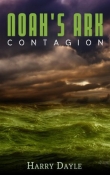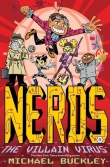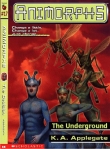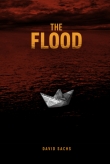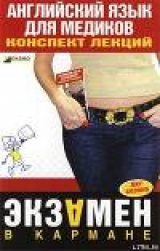
Текст книги "Английский язык для медиков: конспект лекций"
Автор книги: Елена Беликова
Жанры:
Языкознание
,сообщить о нарушении
Текущая страница: 2 (всего у книги 12 страниц)
ЛЕКЦИЯ № 4. Dermis
Dermis is a connective tissue layer of mesodermal origin subjacent the epidermis and its basement membrane. The dermis-epidermal junction, especially in thick skin, is characterized by numerous papillary interdigitations of the dermal connective tissue and epidermal epithelium. This increases the surface area of attachment and brings blood vessels in closer proximity to the epidermal cells. The epidemis, like epithelia in general, is devoid of blood vessel. Histologically, der-mis consists of two identifiable regions.
Papillary layer, associated principally with the dermal papillae, is the most superficial layer. It consists of a loosely packed, irregular meshwork of collagen fibrils that contain fine blood vessels and nerve endings.
Reticular layer is the deeper dermal layer and consists of coarse collagen bundles intertwined with elastic fibers in a gel matrix. This layer is a typical dense irregular connective tissue.
HYPODERMIS: this layer of loose vascular connective tissue is infiltrated with adipocytes and corresponds to the superficial fascia of gross anatomy. However, since it contains the deepest portions of the cutaneous glands and hairs, it is also an important part of the skin. The hypodermis fastens the skin to underlying muscles and other structures.
New words
dermis – дерма
connective – соединительный
membrane – мембрана
junction – соединение
to be characterized by – характеризоваться чем-то
numerous – значительный
to increase – увеличивать
surface – поверхность
area – площадь
bring – приносить
to consists of – состоять из
to contain – содержать
collagen – коллагеновый
Если перед существительным употребляется прилагательное, оно стоит между артиклем и существительным.
E. g. This is a book. This is a good book.
Вставьте артикль, где необходимо
1. We have… large… family.
2. My granny often tells us… long… interesting… stories.
3. My… father is… engineer. He works at… factory… factory is large.
4. My… mother is… doctor. She works at… large. hospital. She is at… work now.
5. My… aunt is… teacher. She works at… school… school is good. My… aunt is not at… school now.
6. She is at… home. She is drinking… tea and eating… jam… jam is sweet.
7. I am at home, too. I am drinking… tea and eating… sandwich… sandwich is tasty.
8. My sister is at… school. She is… pupil.
9. My cousin has… big… black… cat. My cousin's… cat has two… kittens.
10… cat likes… milk… kittens like… milk, too.
11. I am… engineer.
12. My… son is… pupil.
13. He is… good… pupil.
14. This is… house.
15. This is my… pencil.
16. You have some… pen cils, but I have no… pencil. Give me… pencil, please.
17. I like your… beautiful… flower. Give me… flower, please.
18. My… mother is at… home. She is reading… interesting… book.
19. My… father is not at… home. He is at… work. He is… doctor.
20. He is… good… doctor. He works at… hospital… hospital is large.
Answer the questions.
1. What is dermis?
2. What does dermis consist of?
3. What is the dermis-epidermal junction characterized by?
4. What increases the surface area of attachment?
5. What is the epidemis devoid of?
6. What is principally associated with the dermal papillae?
7. What is reticular layer consists of?
8. What is typical dense irregular connective tissue?
9. What does epidermis consists of?
10. What contains the deepest portions of the cutaneous glands?
Make the sentences of your own using the new words (10 sentences).
Find the definite and indefinite articles in the text.
Find one word, which is a little bit different in meaning from others (найдите одно слово, которое немного отличается от других по смыслу):
1) a) skin; b) knife; c) dermis;
2) a) fire; b) membrane; c) cell;
3) a) connective; b) collagen; c) table;
4) a) nose; b) book; c) mouth;
5) a) ear; b) throat; c) skirt.
ЛЕКЦИЯ № 5. Cutaneous appendages
Cutaneous appendages are all derivatives of the epidermis.
Eccrine (merocrine) sweat glands are simple, coiled, tubular glands that are widely distributed over the body. Secretory portions are tightly coiled and consist of a single layer of columnar-like pyramidal cells. They extend deep with in the dermis or hypodermis, where they are surrounded by myoepithelial cells, which aid in the discharge of secretion by contraction.
Duct portions, composed of two cuboidal cell layers, are corkscrew-shaped and open onto the epidermal surface. The luminal diameter of the duct is less than that of the secretory coil. These glands are important in thermal regulation. When hypotonic sweat is released onto the body surface, heat is lost by water evaporation.
Control of the eccrine glands is mainly by the innervation of choli-nergic fibers.
Apocrine sweat glands are also simple, coiled, tubular glands but are much less abundant in their distribution than eccrine glands. They can be found in the axillary, areolar, and anal regions.
Secretory portions of these glands are composed of a single layer of cuboidal or columnar cells. They are larger and have a much wider luminal diameter than eccrine sweat glands. Myoepithelial cells surround the secretory cells within the basement membrane and contract to facilitate secretion.
Duct portions are similar to those of eccrine sweat glands but open onto hair follicles instead of onto the epidermal surfaces.
Functions of these glands in humans is not at all clear. In other mammals, apocrine sweat glands are widely distributed over the body and serve a variety of functions related to olfaction and behavior. Specialized apocrine glands in the ear canal (ceruminous glands) produce a secretion in conjunction with adjacent sebaceous glands to form the protective earwax (cerumen). Apocrine sweat is normally odorless when secreted but becomes noticeable due to the activity of cutaneous bacteria. Control of the apocrine glands is hormonal and via the innervation of adrenergic fibers. These glands do not begin to function until puberty.
Sebaceous glands are simple, branched holocrine acinar glands. They usually discharge their secretions onto the hair shaft within hair follicles. These glands are found in the dermis throught the skin, except on the palms and soles.
Secretory portions consist of peripherally located, flattened stem cells that resemble basal keratinocytes. Toward the center of the acini, enlarged differentiated cells are engorged with lipid. Death and fragmentation of cells nearest the duct portion result in the holocrine mechanism of secretion.
Duct portions of sebaceous glands are composed of stratified squamous epithelium that is continuous with the hair cat and epidermal surface.
Functions involve the lubrication of both hairs and cornified layers of the skin, as well as resistance to desiccation.
Control of sebaceous glands is hormonal. Enlargement of the acini occurs at puberty.
Hairs are long, filamentous projections consisting of dead keratini-zed epidermal cells. Each hair derives from an epidermal invagination called the hair follicle, which possesses a terminal hair bulb, located in the dermis or hypodermis, from which the hair shaft grows. Bundles of smooth muscle cells, called arrector pili muscles, are attached to the hair follicle at one end and the papillary dermis at the other. Contraction of these muscles raise the hairs and dimple the epidermis («goose flesh»). The follicles and associated sebaceous glands are known as pi-losebaceous units.
Nails, like hair, are a modified stratum corneum of the epidermis. They contain hard keratin that forms in a manner similar to the formation of hair. Cells continually proliferate and keratinize from the stratum basale of the nail matrix.
New words
cutaneous – кожный
appendace – покров
coiled – намотанный
tubular – трубчатый
widely – широко
to distribute – распространять
columnar-like – колоночноподобный
pyramidal – пирамидальный
surface – поверхность
duct portions – части трубочки
corkscrew-shaped – имеющий форму штопора
luminal – люминал
thermal – тепловой
innervation – иннервация
abundant – в изобилии
to facilitate – облегчать
Часто, при первом упоминании предмета, тем не менее не рекомендуется перед ним употреблять определенный артикль:
1) если упоминаемый предмет является единственным в мире:
Е. g. The sun is shining brightly;
2) если этот предмет является определенным по ситуации:
Е. g. Put the book on the table.
Вставьте артикль, где необходимо.
1. What's… weather like today? -… weather is fine.
2… sun is yellow.
3… sky is grey today.
4… earth is… planet.
5. We had… English lesson yesterday… teacher asked me many… questions… questions were difficult.
6. Where is your… brother? – He is at… home. He is in his… room. He is sitting at… table. He is doing his… homework… homework is difficult.
7. Our… cat is sitting on… sofa.
8. It is very dark in… room. Turn on… light, please.
9. Nick went into… bathroom, turned on… water and washed his hands.
10. This is… good… book. Take… book from… table. Put this… book into… bookcase.
11… weath er is fine today… sky is blue… sun is shining brightly in… blue… sky.
12. This is… boy… boy is… school. He is… pupil.
13. This… boy is my… brother's friend.
14. He has… cat, but he has no. dog.
15. He likes his…cat.
16. He gives. cat… milk every day.
17. Yesterday I received… letter from my… friend… letter was interesting.
18. We live in… big house. I like… house very much.
19. Are you. worker? – No, I am… student.
20. Is this… table? – Yes, this is a table.
Answer the questions.
1. What are all derivatives of the epidermis?
2. What do secretory portions consist of?
3. How much do secretory portions extend?
4. What are duct portions composed of?
5. In what regulation are glands important?
6. What is surrounded by myoepithelial cells?
7. What is the result in the holocrine mechanism of secretion?
8. What are duct portions of sebaceous glands composed of?
9. What does each hair derive from?
10. What contain hard keratin?
Make the sentences of your own using the new words (10 sentences).
Find the definite and indefinite articles in the text.
Find one word, which is a little bit different in meaning from others (найдите одно слово, которое немного отличается от других по смыслу):
1) a) cutaneous; b) skin; c) face;
2) a) cold; b) heat; c) thermal;
3) a) mouth; b) nose; c) arm;
4) a) nail; b) hair; c) skin;
5) a) neck; b) head; c) string.
ЛЕКЦИЯ № 6. Matter
Matter is anything that occupies space, possesses mass and can be perceived by our sense organs. It exists in nature in three, usually inter convertible physical states: solids, liquids and gases. For instance, ice, water and steam are respectively the solid, liquid and gaseous states of water. Things in the physical world are made up of a relatively small number of basic materials combined in various ways. The physical material of which everything that we can see or touch is made is matter. Matter exists in three different states: solid, liquid and gaseous. Human senses with the help of tools allow us to determine the properties of matter. Matter can undergo a variety of changes – physical and chemical, natural and controlled.
Chemistry and physics deal with the study of matter, its properties, changes and transformation with energy. There are two kinds of properties: physical – colour, taste, odour, density, hardness, solubility and ability to conduct electricity and heat; in solids the shape of their crystals is significant, freezing and boiling points of liquids.
Chemical properties are the changes in composition undergone by a substance when it is subjected to various conditions. The various changes may be physical and chemical. The physical properties are temporary. In a chemical change the composition of the substance is changed and new products are formed. Chemical properties are permanent.
It is useful to classify materials as solid, liquid or gas (though water, for example, exists as solid (ice), as liquid (water) and as gas (water vapour). The changes of state described by the terms solidify (freeze), liquify (melt), vapourise (evaporate) and condense are examples of physical changes. After physical change there is still the same material. Water is water whether it is solid, liquid or gas. Also, there is still the same mass of material. It is usually easy to reverse a physical change.
New words
matter – материя
anything – все
to occupy – занимать
space – пространство
to possesses – владеть, обладать
mass – масса
sense – чувство
organ – орган
steam – пар
to exist – существовать
can – мочь
to undergo – подвергать
variety – разнообрзие
change – перемена
physical – физический
chemical – химический
natural – природный
transformation – трансформация
colour – цвет
taste – вкус
odour – запах
density – плотность
hardness – твердость
solubility – растворимость
ability – возможность
to conduct – проводить
permanent – постоянный
Существует огромное количество так называемых застывших словосочетаний, в которых артикль употребляется или отсутствует традиционно. Эти словосочетания приходится заучивать наизусть.
Запомните следующие конструкции.
There is a…
Where is the…?
Запомните также следующие предложения.
The (book) is on the (table).
Ho: The (book) is on a little (table).
Вставьте артикль, где необходимо.
1. Where is… soup? -… soup is in… big saucepan on… gas-cooker.
2. Where are… cut lets? -… cutlets are in… refrigerator on… lit tle plate.
3. There is no… bread on… table. Where In… bread?
4. There is… little brown coffee-table in our… room in… front of… sofa.
5. Where is… table in your… room?
6. There is… thick carpet on… floor in my mother's room.
7. Is your brother at… home? – No, he is at… work. He works at… big factory. He is… engineer.
8. My sister has many… books… books are in… big bookcase.
9… weather is fine today. Let's go and play in… yard.
10. There are many… children in… yard. They are playing with… ball.
11. Where is… cat? -… cat is on… sofa.
12. Where is… book? -… book is on… shelf.
13. Where are… flowers? -… flowers are in… beautiful vase.
14. Where is… vase? -… vase is on… little table near… window.
15. Open… win dow, please… weather is fine today.
16. I can see… sun in… sky. I can see… nice little bird… bird is sitting in… big tree… tree is green.
17. There is… little white cloud in… sky.
18. We have. large room.
19. There is… big sofa in… room and… little lamp on… wall over… sofa.
20. I like to sit on… sofa and read… good book.
Answer the questions.
1. What is matter?
2. What does matter occupy?
3. Where does matter exist?
4. What are things in the physical world made up of?
5. What states does matter exist in?
6. What can matter undergo?
7. How many kinds of properties are there?
8. Are chemical properties permanent?
9. What may the various changes be?
10. Is it easy to reverse a physical change?
Make the sentences of your own using the new words (10 sentences).
Find the definite and indefinite articles in the text.
Find one word, which is a little bit different in meaning from others (найдите одно слово, которое немного отличается от других по смыслу):
1) a) nothing; b) anything; c) everything;
2) a) sense; b) feeling; c) gas;
3) a) ring; b) odour; c) taste;
4) a) colour; b) green; c) table;
5) a) feet; b) arms; c) molecule.
ЛЕКЦИЯ № 7. Skeletal system
The components of the skeletal system are derived from mesenchy-mal elements that arise from mesoderm and neural crest. Mesenchy-mal cells differentiate into fibroblasts, chondroblasts, and osteoblasts, which produce connective tissue, cartilage, and bone tissue, respectively. Bone organs either develop directly in mesenchymal connective tissue (intramembranous ossification) or from preformed cartilage models (endochondral ossification). In general, the skeletal muscles differentiate from paraxial mesoderm. The splanch nic mesoderm gives rise to cardiac and smooth muscle.
The integument consists of the epidermis and its derivatives (glands, hairs, nails), and the underlying dermis. The epider mis is derived from ectoderm, whereas the dermis is formed from mesenchyme. Melanocytes, which may occur in both layers, originate from neural crest.
The skeletal system develops from paraxial mesoderm, which forms a column of tissue blocks, called the somites, on either side of the neural tube. Each somite becomes differentiated into a ventromedial part, the sclerotome, and a dorsolateral part, the dermomyotome. By the end of the fourth week, the sclerotome cells form embryonic connective tissue, known as mesenchyme. Mesenchyme cells migrate and differentiate to form fibroblasts, chondroblasts, or osteoblasts.
Bone organs are formed by two methods.
Flat bones are formed by a process known as intramembinous ossification, in which bones develop directly within mesenchyme.
Long bones are formed by a process known as endochondral ossification, in which mesenchymal cells give rise hyaline cartilage models that subsequently become ossified.
Skull formation. The neurocranium provides protection around the brain, and the viscerocranium forms the skeleton the face.
Neurocranium is divided into two portions:
The membranous neurocranium consists of flat bones that surround the brain as a vault. The bones appose one another at sutures and fon-tanelles, which allow overlap of bones during birth and remain membranous until adulthood. Palpation of the anterior fontanelle, where the two parietal and frontal bones meet, provides information about the progress of ossification and intracranial pressure.
The cartilaginous neurocranium (chondro-cranium) of the base of the skull is formed by fusion and ossification of number of separate cartilages along the median plate.
Viscerocranium arises primarily from the first two pharynge arches.
Appendicular system: The pectoral and pelvic girdles and the limbs comprise the appendicular system.
Except for the clavicle, most bones of the system are end chondral. The limbs begin as mesenchymal buds with an apical ectodermal ridge covering, which exerts an inductive influence over the mesen-chyme.
Bone formation occurs by ossification of hyaline cartilage models.
The process begins at the end of the embryonic period in the primary ossification centers, which are located in the shaft, or diaphysis, of the long bones. At the epiphyses, or bone extremities, ossification begins shortly after birth.
The cartilage that remains between the diaphysis and the epiphyses of a long bone is known as the epiphysial plate. It is the site of growth of long bones until they attain their final size and the epiphysial plate disappears.
Vertebral column.
During the fourth week, sclerotome cells migrate medially to surround the spinal cord and notochord. After proliferation of the caudal portion of the sclerotomes, the vertebrae are formed, each consisting of the caudal part of one sclerotome and cephalic part of the next.
While the notochord persists in the areas of the vertebral bod ies, it degenerates between them, forming the nucleus pulposus. The latter, together with surrounding circular fibers of the annulus fibrosis, forms the intervertebral disc.
New words
skeletal – скелетный
mesoderm – мезодерма
neural – нервный
crest – гребень
cartilage – хрящ
fibroblasts – фибробласты
chondroblasts – хондробласты
osteoblasts – остеобласты
paraxial – параксиальный
which – который
may – мочь, может
flat – плоский
bone – кость
to provide – снабжать
protection – защита
long – длинный
Запомните следующее застывшее словосочетание.
In front
Запомните следующие конструкции, требующие неопределенного артикля.
I have a…
Не has a…
I see a…
I am a…
He is a.
She is a.
This is a.
That is a.
It is a…
There is a.
Вставьте артикль, где необходимо.
1. We have… big dog… dog is very clever.
2. My friend has… very good computer.
3. This… boy is big. He is… student.
4. There is… very big piano in. hall.
5. This is. tree and that is not… tree. It's. bush.
6. I am… boy. I am… pupil. I learn at… school.
7. My sister is at… work. She is… secretary. She works at… large office.
8. This is… very difficult question. I don't know. answer to it.
9. Do you see… little girl with… big ball in her… hands? She is… pupil of our… school.
10. There was… beautiful flower in this… vase yesterday. Where is … flower now?
Answer the questions.
1. Where the components of the skeletal system are derived from?
2. What do mesenchymal cells differentiate into?
3. What produces connective tissue, cartilage, and bone tissue?
4. What does the splanch nic mesoderm give rise?
5. What does the integument consist of?
6. What is the skeletal system developed from?
7. How many portions is neurocranium divided into?
8. What does the membranous neurocranium consist of?
9. Where does viscerocranium arise primarily?
10. During what week do sclerotome cells migrate?
Make the sentences of your own using the new words (10 sentences).
Find the definite and indefinite articles in the text.
Find one word, which is a little bit different in meaning from others (найдите одно слово, которое немного отличается от других по смыслу):
1) a) bone; b) pen; c) skeletal;
2) a) strong; b)weak; c) powerful;
3) a) water; b)rain; c)steam;
4) a) wind; b) storm; c) easy;
5) a) hot; b)sun; c) winter.

